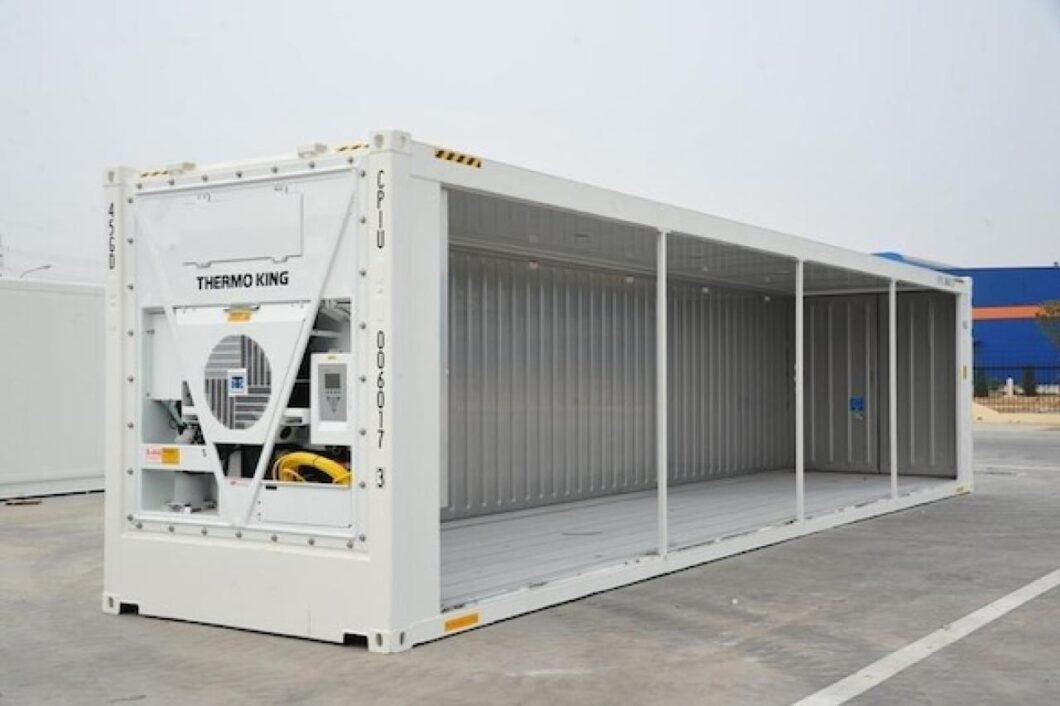We are often asked about refrigerated containers, commonly known in the maritime transportation industry as “reefers.” As we have already discussed, one of the main challenges when building a home with containers is adding insulation. Without insulation, your container will be noisy and, more importantly, uncomfortably warm or cold depending on your climate.
Refrigerated containers are a crucial part of the “cold chain,” a parallel supply chain that handles temperature-controlled products. Products like meat, dairy, fruits, vegetables, and even flowers and pharmaceuticals often rely on the cold chain. If you’ve ever wondered how you can buy out-of-season fruits, for example, you can thank the invention of the refrigerated container.
Therefore, when looking at the various types of containers available, it’s natural to wonder if a refrigerated container could be a better starting point than a traditional container. A refrigerated container is already insulated, which saves you the time and expenses of doing this yourself, right? Well, the answer is a bit more nuanced.
Let’s analyze some aspects of refrigerated containers and see how they “stack up” against regular containers (and yes, that was a container pun on stacking!)
Cost of Refrigerated Containers
The primary motivation for people to explore using a refrigerated container for their container home is cost.
The idea is that if you can buy a refrigerated container for just a little more than a regular container, you wouldn’t have to pay for insulation, and overall, you would save money. Whether this is true or not depends mainly on how affordably you can acquire a refrigerated container.
In general, refrigerated containers cost around 50% more than standard containers of the same size. However, this figure largely depends on where you are in the world and the prevalence of refrigerated containers there.
Size of Refrigerated Containers
To talk about size, we first need to understand the type. In reality, there are two types of cooling systems used in refrigerated containers:
- Integrated (cooling equipment attached and within the container’s size)
- External or clip-on (cooling equipment attached temporarily or placed near the end of a container, with ducts entering and exiting the container through portholes)
When most people think of refrigerated containers, they think of the integrated type, but it’s essential to understand that it’s not the only option. For the purposes of this article, let’s assume that when we say “refrigerated containers,” we are referring to the integrated type.
Refrigerated containers are available in most standard container sizes, including high cube (HC), so there’s no issue with their interface with regular containers. However, what may be a concern is the internal floor area.
Since the cooling equipment is integrated into the container, it has to fit somewhere. That somewhere, as shown in the image above, is the end of the container.
Approximately the last two feet of the container are dedicated to cooling equipment, leaving your interior two feet LESS in length. While two feet may not seem like much, it can be up to 5-10% of the length of your container and, consequently, up to 5-10% of your floor area.
What might you have to sacrifice in your design to account for these two feet less in length? A closet? A couch? While this sacrifice can be addressed, it’s certainly something to consider.
You might be thinking to yourself, “What if I just remove the cooling equipment and reclaim the two feet of space that is legitimately mine?”
This is an option, but not without its own issues. If you plan to reuse the cooling equipment (which we’ll address in the next section), you would need to fabricate a support to hold the equipment since the container would no longer support it.
You would also have to extend the ducts from the cooling equipment to the container. However, perhaps the most significant problem with removing the cooling equipment and reclaiming the space is how to add the new open space to the existing enclosed space.
For starters, you would have to cut the end cap of the container, push it out two feet, and reattach it to the frame.
Then, you would need to obtain an additional two feet of exterior sheets, insulation, and interior sheets to cover the sides, roof, and floor.
Clearly, it would be a substantial undertaking, and you might have trouble getting your two-foot addition to match the rest of the container.
In addition to the two feet that the cooling equipment occupies, you also need to consider the thickness of the insulation. A typical refrigerated container has 3-4 inches less interior width than a standard container.
However, if you’re going to insulate your container anyway (and you should!), this shouldn’t be a concern, as your self-installed insulation would likely occupy approximately the same space.
Cooling Equipment
As mentioned earlier, the cooling equipment is within the external envelope of the container but outside the enclosed space.
The cooling equipment, like your home refrigerator or air conditioner, consists of mechanical components that require electricity to operate.
When you buy a standard container, there are no moving parts other than door hinges and locking mechanisms, so there isn’t much that can break. However, the mechanical system of a refrigerated container has more ways to fail.
Assuming you don’t plan to use it, that’s not a concern. Many people go in this direction and purchase Non-Operating Reefer (NOR) units. However, if you have aspirations of reusing the cooling equipment, you may need some repair work.
More importantly is how you would power it. Most refrigeration containers are designed to receive electrical power from the ship during maritime transit and from the port while on land.
During overland transit, they generally run on diesel generators called gensets.
The required power service is usually high-voltage three-phase power. This is a more efficient method of supplying power for large industrial uses, as it allows the same amount of power to be transmitted through smaller-diameter conductive wires.
However, most residential electrical services do NOT have this type of electrical power available. To use the cooling equipment, you would need to modify or retrofit some of the subcomponents with alternatives that are compatible with the electrical service in your geographic area.
Refrigerant
Most refrigerators and air conditioners utilize a thermodynamic process known as the vapor compression cycle. The cycle relies on specific components like a compressor, evaporator, condenser, and expansion valve.
But the real magic of the cycle is the refrigerant, a special chemical that serves as the working fluid of the cycle. Unlike water, which boils at 100°C (212°F) at sea level, refrigerants can boil at much lower temperatures, allowing them to absorb heat from a warm room.
Without getting too technical, just know that, along with the incredible usefulness of a refrigerant for cooling, there’s the fact that it can be toxic and/or harmful to the atmosphere.
If you choose to purchase a refrigerated container and don’t use the refrigeration equipment, it’s best to have a professional assist you in recovering and disposing of the refrigerant, as these systems can develop leaks over time.
Floors in Refrigerated Containers
Unless you’ve seen a refrigerated container in person, you may not be aware of the design of its floor systems. While traditional containers have smooth metal or plywood floors, refrigerated containers feature special metal floors (typically aluminum).
This floor system, known as a T-floor, T-grid, T-style floor, or T-section floor, has a T-shaped profile that keeps the container’s contents elevated to allow cold air to flow beneath.
The unmodified T-floor is not suitable for a container home, given the deep channels that would trap dirt and snag chair legs and shoe tips. Therefore, you would need to place another floor on top of the T-floor or remove the T-floor and replace it.
Since most people replace the existing plywood floor or seal it in a typical container, modifying the floor in a refrigerated container is not necessarily more work, and you shouldn’t have to deal with the pesticides that manufacturers often use in traditional container wood floors.
However, we recommend that you think it through carefully and have a plan that takes into account the time, expenses, and impacts of the interior ceiling height of any modification you’re considering.
If you are in a cold climate and have considered using radiant floor heating, the T-floor can be an advantage. With some modifications, you can use the channels to secure water pipes for your radiant heating system and then place plywood or another floor covering over the T-floor.
Walls of Refrigerated Containers
One last thing to consider in a refrigerated container is the walls. Unlike traditional containers with corrugated steel walls, a refrigerated container has walls made of a sandwich of durable materials on both sides of the insulation.
This sandwich is typically made of stainless steel panels on both the interior and exterior with a thickness of 0.8 to 1.2 mm. The exterior is usually painted white, while the interior may be left uncoated.
In some cases, you may find the interior made of fiber-reinforced plastic, offering weight savings, chemical resistance, and easier repair than stainless steel.
The wall sandwich is usually smooth both on the interior and exterior of the container, providing a different aesthetic than the corrugated steel of standard containers. Depending on your design and appreciation for different visual styles, this can be a pro or a con for you.
Cutting this sandwich for doors, windows, and utility penetrations is not much more challenging than with other containers. However, you must ensure that the interior and exterior openings align if you don’t have a cutting method that can cut through the sandwich’s thickness in a single pass. Given the presence of insulation, you should be cautious with fire, and we recommend not using a torch for the cutting process.
Walls are also where most electrical outlets and plumbing fixtures are mounted. In standard container construction, you would hide the pipes and electrical lines within the interior walls where the insulation is placed.
Since the walls of a refrigerated container are already built, you can cut part of the wall sandwich (and remove the insulation) to place the lines and then cover the cuts with new sheets.
Alternatively, you can simply surface-mount the lines inside the wall sandwich. The first option is more work, while the second is likely to be less aesthetically pleasing.
Structure of Refrigerated Containers
We previously discussed the difference in materials used for the cladding of walls, floors, and the roof of a container. However, the structural elements are almost the same as those of standard containers.
In most cases, the corners, top rails, bottom rails, and other main structural pieces are built with Corten steel, as expected.
This is what allows refrigerated containers to have a high level of strength, be stacked alongside standard containers, and more.
Summary
As you can see, the decision to use a refrigerated container for your container home is influenced by several factors that you may not have considered. Hopefully, this discussion will help you better understand the impact this decision will have on your construction.
Unfortunately, with the significant variability in prices and conditions of refrigerated containers, there is no universally correct answer to whether or not to use a refrigerated container. Instead, weigh the various factors and make the best decision for yourself, your construction, and your geographical area.
Furthermore, one related element we haven’t addressed in this post is insulated and non-refrigerated containers. These containers do not have refrigeration equipment and instead rely on dry ice or other liquid vaporization processes that provide a finite amount of cooling for a few days or weeks.
If you have built a home with refrigerated containers or planned to use one and then changed your mind, we’d love to hear about your experience in our comments section below.




